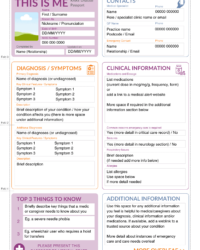An archive inventory template is a valuable tool for organizing and managing physical and digital archives. It provides a structured format for documenting and tracking the contents of an archive, ensuring efficient retrieval and preservation. These templates encompass essential information such as item descriptions, provenance, handling instructions, and storage locations.
Archives play a crucial role in preserving our collective knowledge and heritage. They house a wealth of materials, from historical documents and artifacts to digital records and electronic archives. Managing these vast collections effectively requires a systematic approach. Archive inventory templates offer a standardized framework for documenting the contents of an archive, making them indispensable for archivists and researchers alike.
The benefits of using an archive inventory template are numerous. It streamlines the inventory process, ensuring that all necessary information is captured consistently. By providing a predefined structure, templates minimize the risk of omissions and errors, fostering data accuracy and integrity. Moreover, they facilitate the creation of detailed inventories that serve as a valuable resource for archivists, researchers, and the public alike.
Essential Components of an Archive Inventory Template
Archive inventory templates vary in their specific components, but they generally include the following essential elements:
**Item Identification:** This section captures basic information about each item in the archive, including its unique identifier, title, and physical description. Other relevant details may include the item’s creator, date of creation, and any associated contextual information.
Item Condition and Handling
This section documents the physical condition of each item, noting any damage or deterioration. It also provides specific handling instructions to ensure the item’s preservation and longevity. Archival materials often require specialized handling procedures to prevent further degradation, making this information crucial for proper care.
Storage Location and Retrieval
An essential component of any archive inventory template is the documentation of each item’s storage location. This information enables archivists and researchers to easily locate and retrieve items as needed. The template should include the physical location, such as the shelf or box where the item is stored, as well as any access restrictions or special retrieval procedures.
Provenance and History
Provenance refers to the history of ownership and custody of an item. This section of the template documents any known provenance information, providing valuable context for researchers and enhancing the item’s authenticity and significance. The template should capture information about previous owners, donors, and any transfers or changes in ownership.
Access and Use Restrictions
Some archive items may have access restrictions due to copyright, privacy concerns, or other legal or ethical considerations. The inventory template should include a section to document any access or use restrictions, ensuring compliance with relevant regulations and respecting the rights of creators and donors.
Benefits of Using an Archive Inventory Template
The use of an archive inventory template offers numerous benefits for archivists, researchers, and the public:
**Standardized Inventory Process:** The template provides a consistent framework for documenting archive contents, ensuring that all necessary information is captured accurately and comprehensively. This standardization streamlines the inventory process, reduces errors, and facilitates data sharing.
Enhanced Accessibility and Retrieval
Well-organized inventories make it easier for researchers and the public to locate and retrieve archive items. By providing detailed descriptions, storage locations, and handling instructions, the template enables efficient access to the collection.
Preservation and Conservation
Archive inventory templates contribute to the preservation and conservation of archival materials. By documenting item condition and handling instructions, the template ensures that items are handled and stored appropriately to minimize deterioration and extend their lifespan.
Research and Scholarship
Comprehensive archive inventories provide valuable resources for researchers and scholars. The detailed information captured in the template facilitates the discovery and exploration of historical and cultural materials, contributing to the advancement of knowledge and understanding.
Public Engagement and Outreach
Archive inventories can also serve as a means of public engagement and outreach. By making inventory information accessible online or through other channels, archives can share their collections with a broader audience, fostering a greater appreciation for our collective heritage.
In conclusion, an archive inventory template is an indispensable tool for effectively managing and preserving archive collections. By providing a standardized framework for documenting essential information, these templates streamline the inventory process, enhance accessibility, contribute to preservation efforts, support research and scholarship, and facilitate public engagement with archival materials.


